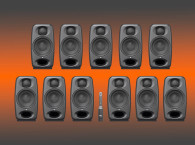
The latest update to Sonarworks' SoundID Reference allows exporting the calibration profile directly into the DSP of RME interfaces, eliminating the need to run the software in the background. This process is simple to execute and takes advantage of RME's own TotalMix FX configuration and control software and AD/DA converters.
The ROOM EQ is a DSP section added to RME's TotalMix FX for select interfaces. It consists of nine (9) bands of fully parametric EQ, individual output delay, and volume calibration. Users can freely assign up to twenty (20) ROOM EQs at once to any output(s) they wish including stereo, headphone, and digital outputs for maximum flexibility.
These calibration Settings can now be imported from Sonarworks SoundID Reference making the implementation faster and more convenient. "It is our goal to make the process of room calibration as simple as possible for RME customers wishing to calibrate their studios using the new built-in ROOM EQ from RME," says Derek Badala Sonarworks Director of Sales - The Americas.
"This new feature that Sonarworks has added to SoundID Reference gives the RME user an easy DIY calibration solution, especially the version that includes the calibration mic. Once they finish the measurement process they will have the option to export their calibration results to a file(s) that can be easily imported into RME's TotalMix FX. For multichannel situations like Dolby Atmos, users can even choose which outputs they want to import their calibrations."

A built-in ROOM EQ function in hardware offers greater advantages than traditional software approaches to room calibration. "A built-in hardware solution reduces latency and CPU usage along with the overall convenience of not having to run separate software or plug-ins in the background or in your DAW," adds Derek Badala. "In addition to convenience, users no longer have to worry about accidentally printing the EQ settings on their mix files, and there are no driver/software bugs to contend with. It's easy to access right in TotalMix on your outputs."
Existing Sonarworks customers can download an update for their SoundID Reference software to add the RME compatibility to their existing setup. The following RME interfaces now come with the ROOM EQ functionality: Fireface UFX III, UFX+, UFX II, 802 FS, or UCX II, and HDSPe MADI FX rev2.
The firmware update provides these RME interfaces with an optimized handling of the existing 3-band PEQ in TotalMix FX. Under the hood a 9-band PEQ is built from three 3-band PEQs, usable on any output channel. Obviously DSP power is limited, so any activated Room EQ reduces the available total number of 3-band PEQs by that amount. That should be no issue though, there are plenty available.

The maximum number of Room EQs is 20, so up to 20 mono output channels or 10 stereo output channels or any combination of these. That’s more than needed for a 16 channel surround setup. Additionally, the Room EQ window includes delay, adjustable from 0ms up to 42ms, in steps of 0.01ms. Up to 20 of these delays can be activated, matching the number of 9-band PEQs.
The Room EQ window also offers Volume Calibration through level adjustment from +3dB down to -24dB. This helps to set up all speakers in a usable way, without having to fiddle with the respective output channel's fader.
For headphone mixing, RME also added the ADI-2 series' Crossfeed function. Crossfeed can be selected in 5 ‘strenghts’, on a maximum of 3 stereo outputs. Crossfeed emulates speaker behavior in terms of reduced channel separation, so the extreme wide ambiance often experienced with headphones is reduced a bit.
www.synthax.com
www.rme-audio.de | www.rme-usa.com
www.sonarworks.com







